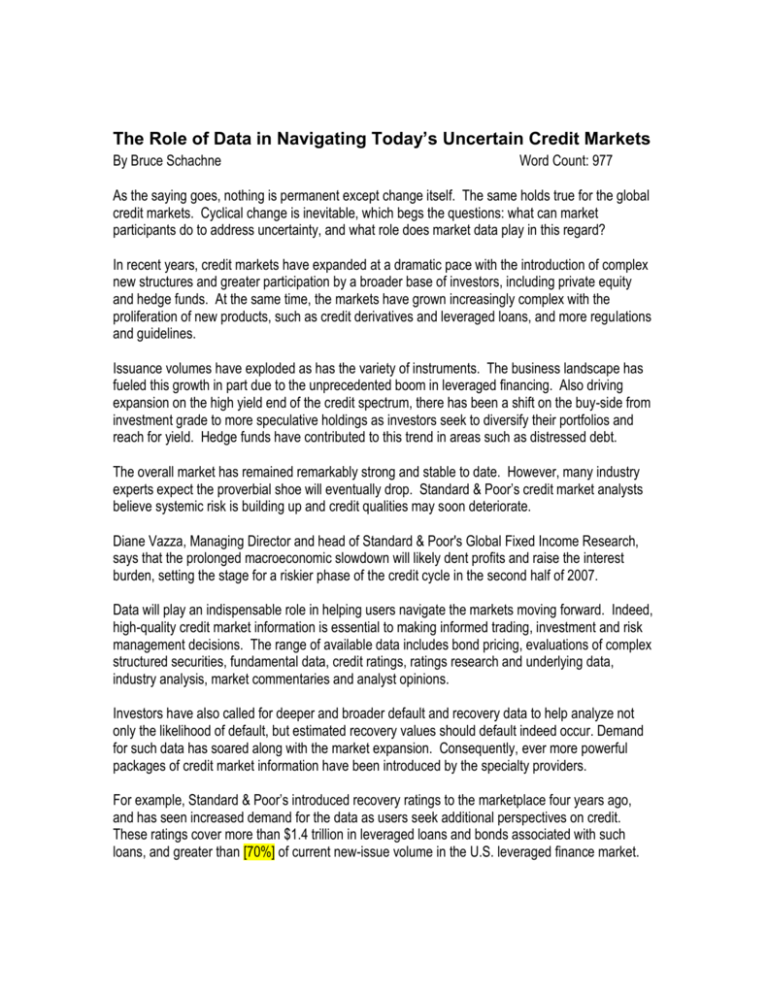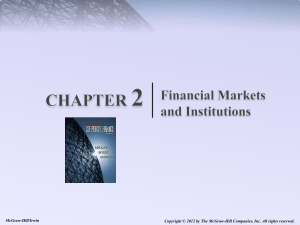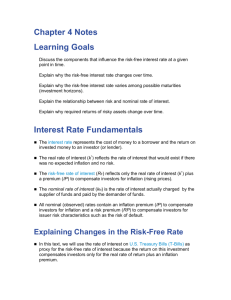The Role of Data in Navigating Today`s Uncertain Credit Markets
advertisement

The Role of Data in Navigating Today’s Uncertain Credit Markets By Bruce Schachne Word Count: 977 As the saying goes, nothing is permanent except change itself. The same holds true for the global credit markets. Cyclical change is inevitable, which begs the questions: what can market participants do to address uncertainty, and what role does market data play in this regard? In recent years, credit markets have expanded at a dramatic pace with the introduction of complex new structures and greater participation by a broader base of investors, including private equity and hedge funds. At the same time, the markets have grown increasingly complex with the proliferation of new products, such as credit derivatives and leveraged loans, and more regulations and guidelines. Issuance volumes have exploded as has the variety of instruments. The business landscape has fueled this growth in part due to the unprecedented boom in leveraged financing. Also driving expansion on the high yield end of the credit spectrum, there has been a shift on the buy-side from investment grade to more speculative holdings as investors seek to diversify their portfolios and reach for yield. Hedge funds have contributed to this trend in areas such as distressed debt. The overall market has remained remarkably strong and stable to date. However, many industry experts expect the proverbial shoe will eventually drop. Standard & Poor’s credit market analysts believe systemic risk is building up and credit qualities may soon deteriorate. Diane Vazza, Managing Director and head of Standard & Poor's Global Fixed Income Research, says that the prolonged macroeconomic slowdown will likely dent profits and raise the interest burden, setting the stage for a riskier phase of the credit cycle in the second half of 2007. Data will play an indispensable role in helping users navigate the markets moving forward. Indeed, high-quality credit market information is essential to making informed trading, investment and risk management decisions. The range of available data includes bond pricing, evaluations of complex structured securities, fundamental data, credit ratings, ratings research and underlying data, industry analysis, market commentaries and analyst opinions. Investors have also called for deeper and broader default and recovery data to help analyze not only the likelihood of default, but estimated recovery values should default indeed occur. Demand for such data has soared along with the market expansion. Consequently, ever more powerful packages of credit market information have been introduced by the specialty providers. For example, Standard & Poor’s introduced recovery ratings to the marketplace four years ago, and has seen increased demand for the data as users seek additional perspectives on credit. These ratings cover more than $1.4 trillion in leveraged loans and bonds associated with such loans, and greater than [70%] of current new-issue volume in the U.S. leveraged finance market. Another change impacting market data supply and demand is the diminishing number of sell-side shops that distribute proprietary fixed income research externally. This has caused many firms to consume more market data in-house, and left a handful of sources of respected credit market opinion. Emerging guidelines on sell-side research integrity have further compounded demand for credit market information. For instance, SIFMA (Securities Industry and Financial Markets Association) is seeking comment on its “Guiding Principles,” aimed at enhancing investor protection by managing potential conflicts of interest on the part of institutions that underwrite and trade debt securities and distribute research about those securities to investors. According to the guidelines, the credit rating agencies play a vital role in the fixed income markets by providing “market participants with an independent source of information regarding the relative creditworthiness of debt and other fixed income instruments as well as various corporate and other debt issuers.” The guidelines go on to say that “the reasoned and categorical assessments of the relative creditworthiness of debt securities and issuers generated by rating agencies and independent research firms, coupled with market forces, provide an important independent resource for investors and other participants in the fixed income markets. These resources also provide an independent ‘check’ on the accuracy and reliability of ‘sell-side’ fixed income research.” Business compliance and regulatory rules require institutional investors to exercise the greatest possible due diligence in selecting suitable vehicles for their clients. On both the sell-side and buyside, a documented audit trail of data has therefore become a cost of doing business. These and other trends have led market players to place greater emphasis on third-party, independent data to benchmark and justify their trading, investment and risk management decisions. While the breadth and depth of market information has increased to meet demand, technology has also evolved to improve data access and availability. As well, data providers are changing the way they do business to accommodate client demand for flexible access. For instance, it is now possible to access databases of default and recovery statistics and history as standalone packages. In addition to charts, customers can download underlying data points directly into their proprietary research and analytic solutions as part of these packages. These and other innovations have spurred change industry-wide as the markets have grown. Meanwhile, industry analysts are studying the historic levels of leverage closely, and many are concerned about tightening credit conditions going forward. Credit spreads are uncommonly narrow not only because of macroeconomic forces and the entrance of private investment funds in the high yield segment of the markets, but also because of the shortage of bond supply, as investors have willingly assumed more risk. Eventually, the credit cycle will turn. When it does, the default rate will rise and recovery ratings will be tested. The exceptional levels of leverage will be exceedingly stressed and investors exposed to these sectors will be called to task if they have not hedged their portfolios appropriately. Market participants will be best positioned to stay abreast of the trends by relying on extensive current, historical and predictive credit market information. Indeed, deep and reliable data and insight will be vital to navigating the inevitable market vagaries to come. ###











